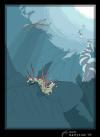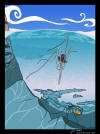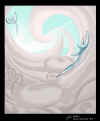
I originally added this series of comic-style illustrations to the Indie Art section, but since they are paleontological in nature, I thought I'd add them here in Paleoart as well and give more detailed explanations of them. First let me state that these are NOT paleoart in the true sense of the word. These cartoons are instead whimsical interpretations of creatures that range from the earliest known animal life--the Ediacaran and Burgess Shale fauna, to species from various, more recent time periods (hence the new name for this series, "Trans-Cambrian"). Rather than try for strict scientific accuracy in these illustrations, I exaggerated many aspects of the creatures depicted based on my own impressions of them.
| Daydream Adobe Photoshop 7 3/2/2005 Purchase Print The first drawing in this series is titled "Daydream." It depicts two Cambrian animals: Hallucigenia sparsa ("scattered hallucination") and Pikaia gracilens ("thin Mount Pika one"). The title, of course, is a reference both to Hallucigenia herself and the dream-like quality I was shooting for in this series. Hallucigenia is probably the most bizarre member of the Burgess Shale fauna, and even simple facts such as which end went up have been debated for years (i.e., did it go spikes up or tentacles up? It is widely accepted now that the tentacles served as feet). It is most likely a member of the modern group onychophora, or velvet worms, relatives of the arthropods. In the drawing I exaggerated the head area and made tentacles look like antennae. I also exaggerated the curvature of the spines. Hallucigenia was tiny--half an inch long--and the exaggerated perspective in the drawing is meant to convey her sense of her underwater world. Above Hallucigenia swim two Pikaia, the earliest known chordate (and your distant ancestors!). These animals, probably predatory, were three times the size of Hallucigenia at 1 1/2 inches long. Hallucigenia's journey down into the tropical geothermal vent is meant to be a bit surreal, and the tone of this drawing was inspired by the song "Having A Moment" by Kinobe. |
|
| Mondo Exotica Macromedia Flash MX and Adobe Photoshop 7 6/10/2005 Purchase Print The second drawing in the series is titled "Mondo Exotica." In it, a swimming Leanchoilia superlata ("the utmost from Leanchoil Station") drifts above several Wiwaxia corrugata ("rigid windy one"). Leanchoilia was an arthropod related to trilobites. It did not have any eyes, and to make up for its blindness, it possessed strange tentacle-like sensory organs at the front of its body. The tentacles of the creature in "Mondo Exotica" are based more on Leanchoilia illecebrosa, which were longer than usual (mine are still greatly exaggerated to stream more dramatically behind the forward-swimming creature). The main body of this creature grew up to two inches long. Scouring the rocks below for food
are two Wiwaxia, a strange creature (possibly a type of slug) with a round body
covered entirely with scale-like armor, with a series of long scales jutting off the back
for defense. Wiwaxia ranged in size from 1/8 of an inch to two inches long. The
tone of this drawing is brighter and more tropical than the last, and certainly more
whimsical, with the remains of an ancient (Precambrian?) tiki statue overlooking the
lagoon. This hallucination was constructed upon a substrate of "So Easy" by
Röyksopp. |
|
| Look Up Macromedia Flash MX and Adobe Photoshop 7 9/16/2005 Purchase Print This third drawing in the series is called "Look Up" (the title itself a Zero 7 song reference). It features the earliest known member of Cephalopoda, the group which contains nautilus, octopi, squids, etc. Plectronoceras (which means something like "guitar pick horn"), unlike its modern relatives, had a very simple cone-shaped shell, showing the beginnings of a chambered structure that categorizes more derived molluscs like ammonites and nautiloids. Only the shells are known and no soft body imprints have been found, but I've reconstructed it based on the illustration in the original description, as a sort of half-squid half-snail. Plectronoceras is climbing along the stem of a Margaritia sp., an aptly-named relative of modern kelp that lived in the Cambrian period, along with our squiddy friend there. The burst of light from a far-off surface and strand of bubbles from some unseen floor is best enjoyed while listening to "Lovely Head" by Goldfrapp. |
|
| Somersault Adobe Illustrator 10 and Photoshop 7 10/17/2005 Purchase Print I'd had this idea for a while before implementing it. After using Monkey Island-like clouds in Mondo Exotica I figured I'd go all out, and who better to inhabit this quirky, twisting sky than my mascot? Here, two Azhdarcho lancicollis ("lance-necked dragon") perform the action of the title while soaring and riding thermals. For large pterosaurs like this, which made a living on the ground picking off baby dinosaurs with their sharp, pointed beaks, soaring was probably the preferred mode of transport. While not a giant like some of its family members (which could reach upwards of 30ft in wingspan), Azhdarcho probably reached a respectable 15 feet from wingtip to wingtip, though considering the relatively short wings on azhdarchid pterosaurs, this may be an overestimate. The wing structure of pterosaurs is still controversial. I've restored the azhdarchs here after the model proposed by pterosaurologist Jim Cunningham, with a prominent uropatagia (wing membrane between the legs) forming a sort of tail fin or hind wing apparatus. Pterosaurs were probably better at flying than birds or bats. Their wing membrane consisted of thin muscle fibers called actinofibrils. This muscle, combined with the mobility of the legs and fingers, meant that pterosaurs had excellent control of their overall wing shape and could adapt its structure on the fly, so to speak. Leisurely cruising at this altitude required good recordings of "Surfing on a Rocket" by Air. |
|
Moonlight and Mescaline The style of the moon is once again taken from MI3, and the arch is modified after Corona Arch in Utah. To initiate the vision quest, smudge with burning sage and retreat into a sweat lodge of "Moonlight and Mescaline" by Kinobe. |




